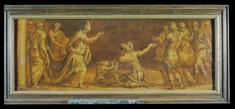The Fall of Manna
(Renaissance Europe )
Vasari may have painted this biblical scene as well as three others (Walters 37.1177, 37.1705, 37.1176) in brown monochrome as a study for related compositions in a series of 18 larger, multicolor panels representing the correspondences between the Old and New Testaments made in 1545-1546 for the sacristy of the church of San Giovanni a Carbonara in Naples. Vasari's skill with the pen comes out in the preliminary drawings, visible in this work, to which he added layers of paint with his brush and fingers.
These particular subjects relate to the establishment of the Holy Eucharist (Communion), when the priest at the altar symbolically re-enacts the sacrifice of Christ. In The Fall of Manna, God provides food for the starving Israelites in the desert.
Provenance
Provenance (from the French provenir, 'to come from/forth') is the chronology of the ownership, custody, or location of a historical object. Learn more about provenance at the Walters.
Don Marcello Massarenti Collection, Rome [date and mode of acquisition unknown] [1897 catalogue: no. 237, as Polidoro da Carabaggio]; Henry Walters, Baltimore, 1902, by purchase; Walters Art Museum, 1931, by bequest.
Exhibitions
| 1961 | Bacchiacca and his Friends. Baltimore Museum of Art, Baltimore. |
Geographies
Italy, Florence (Place of Origin)
Measurements
Painted surface H: 12 5/8 x W: 33 3/8 x D excluding cradle: 5/16 in. (32.1 x 84.8 x 0.8 cm)
Credit Line
Acquired by Henry Walters with the Massarenti Collection, 1902
Location in Museum
Accession Number
In libraries, galleries, museums, and archives, an accession number is a unique identifier assigned to each object in the collection.
In libraries, galleries, museums, and archives, an accession number is a unique identifier assigned to each object in the collection.
37.1704




